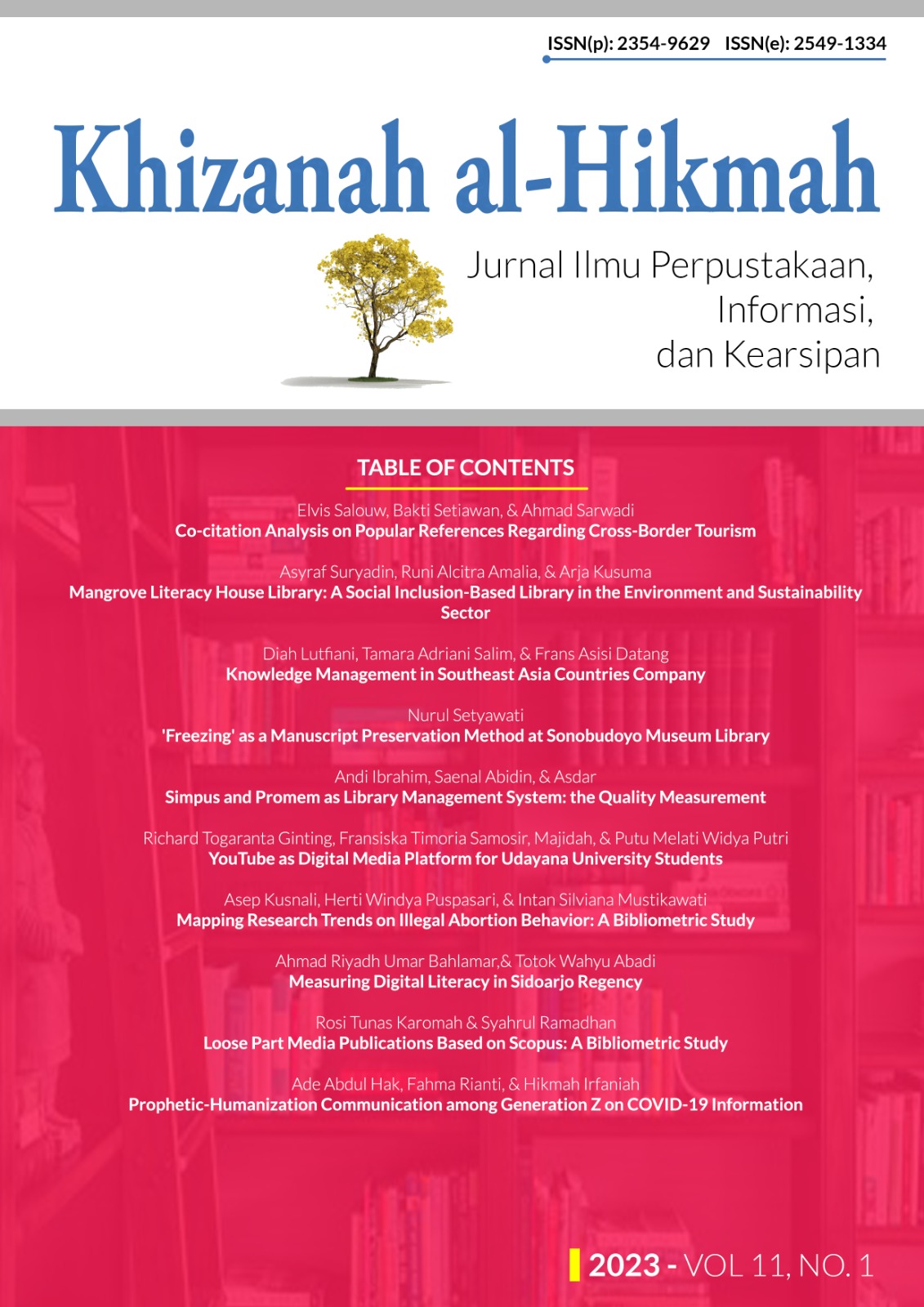Evaluation of Medical Student Satisfaction on the Implementation of Integrated Practicum in Indonesia Museum of Health and Medicine
Abstract
The Indonesia Museum of Health and Medicine (iMuseum), since 2019, has been carrying out the Growth and Development Module Integration Practicum for medical students. This practicum integrates basic medical science (Embryology) and clinical (Children's Health) within the scope of human development, from conception to adulthood. To assess the success of the program, an evaluation of student satisfaction questionnaire data has been carried out on the implementation of the 2020-2022 practicum in a cross-sectional manner. A total of 449 respondent data were successfully processed, consisting of FKUI internal (n=308) and external (n=141) student data. Overall, students have good satisfaction, (3.79; SD 0.36). External students have higher satisfaction (3.87; SD 0.23) compared to internal students (3.78; SD 0.32); independent-t test; t=3.395 (t>1.96); p=0.001 (p<0.05). However, this satisfaction score is not correlated with the value post-test (data for the External group 1; Spearman's test p=0.412 [p>0.05]; rs=0.102). Mark post-test the average reached the number A, namely 86.08 (SD 7.77). It was concluded that the Growth and Development Module Integration Practicum has provided satisfaction to medical students properly.
Downloads
References
Bakrie, M., B. Sujanto, & Rugaiyah. (2019). The influence of service quality, institutional reputation, student’s satisfaction on student’s loyalty in higher education institutions. International Journal for Educational and Vocational Studies. 1 (5), 379-391. https://doi.org/10.29103/ijevs.v1i5.1615
Beatty, I. D., & Feldman, A. (2009). Illuminating teacher change and professional development with CHAT. In Proceedings of the NARST Annual Meeting, April (pp. 17-19). Dehghan, A., Dugger, J., Dobrzykowski, D., & Balazs, A. (2014). The antecedents of student loyalty in online programs. International Journal of Educational Management, 28(1), 15-35. https://doi.org/10.1108/IJEM-01-2013-0007
Eagleton, S. (2015). An exploration of the factors that contribute to learning satisfaction of first year anatomy and physiology students. Advances in Physiology Education, 39(3), 158- 166. https://doi.org/10.1152/advan.00040.2014
Guilbault, M. (2016). Students as customers in higher education: reframing the debate. Journal of Marketing for Higher Education, 26(2), 132-142. https://doi.org/10.1080/08841241.2016.1245234
Haroon, J. A. (2010). An evaluative study of the english language practicum program at the college of languages and translation at Al-Imam Muhammad Ibn Saud Islamic University. Al Imam Muhammad Ibn Saud Islamic University, 49.
ICOM (2022, August 24). ICOM approves a new museum definition. International Council of Museums. Retrieved April 14, 2023, fromhttps://icom.museum/en/news/icom approves-a-new-museum-definition/
Khan, J. & J. Hemsley-Brown. (2021). Student satisfaction: the role of expectations in mitigating the pain of paying fees. Journal of Marketing for Higher Education, 1-23. https://doi.org/10.1080/08841241.2021.1973646
Lumc.nl. Educational Facilities Anatomical Museum. Retrieved April 14, 2023, fromhttp://www.lumc.nl/en/education/onderwijsfaciliteiten/anatomical-museum/ Mareez, Y. M. A-H & N.A Willems. (2014). The use of medical school museums in teaching anatomy within an integrated medical curriculum. Springer International Publishing Switzerland, 30, 267-275. https://doi.org/10.1007/978-3-319-08930-0_30 Medicine.nus.edu.sg. Anatomy Museum Visit. Retrieved April 14, 2023, fromhttp://medicine.nus.edu.sg/ant/Education/museum.html#
Minister of Education, Culture, Research and Technology. (2022). Regulation of the Minister of Education, Culture, Research and Technology of the Republic of Indonesia Number 24 of 2022 concerning Regulations for Implementing Government Regulation Number 66 of 2015 concerning Museums. Ministry of Education, Culture, Research and Technology. Jakarta.
Indonesian government. (2015). Government Regulation of the Republic of Indonesia Number 66 of 2015 concerning Museums. Ministry of State Secretariat of the Republic of Indonesia. Jakarta. Prystowsky, J. B., & Bordage G. (2001). An outcomes research perspective on medical education: the predominance of trainee assessment and satisfaction.Medical Education Online, 35(4), 331-6. https://doi.org/10.1046/j.1365-2923.2001.00910
Ruso, L., & E. B. Topdal. (2014). The use of museums for educational purposes using drama methods. Social and Behavioral Sciences, 141, 628–632. https://doi.org/10.1016/J.SBSPRO.2014.05.110
Sangestani, G., & Khatiban, M. (2013). Comparison of problem-based learning and lecture-based learning in midwifery. Nurse Education Today, 33(8), 791-795. https://doi.org/10.1016/j.nedt.2012.03.010
Sari, N. M., Affiani, H., Dewi, S. P., Wahyudi, K., Achadiyani, Susanah, S., & Hilmanto, D. (2016). Correlation of the level of student satisfaction in the Medical Profession Study Program (PSPD) and the scores of the Medical Profession Program Student Competency Examination (UKMPPD).Lampung University Medical Journal, 1(2), 296-301. https://doi.org/10.23960/jkunila12296-301
Savitri, D. (2023). 5 of the Best Medical Department Campuses in Indonesia, QS WUR by Subject 2023 version. detikcom. Retrieved on May 14, 2023, fromhttps://www.detik.com/edu/perguruan-tinggi/d-6635278/5-kampus-jurusan medical-terbaik-indonesia-versi-qs-wur-by-subject-2023
Soemantri, D., Liem, I.K., Hegar, B. (Eds.). (2022).From Vision to Reality: Respect for Past, Facing the Future. Jakarta: Indonesian Medical Education and Research Institute, Faculty of Medicine, University of Indonesia (IMERI-FKUI).
Wulandari, D., Arifin, S., Cahyono, E. Kusumawardani, S. S., Hertono, G. F., Wastutiningsih, S. P., … & Jobih. (2021).Guide to the Collaborative Curriculum Assistance Program and Implementation of Independent Learning-Independent Campus.Jakarta: Directorate of Learning and Student Affairs, Directorate General of Higher Education, Ministry of Education and Culture.
Ziaee, V., Z. Ahmadinejad, & A. R. Morravedji. (2004). An evaluation on medical students satisfaction with clinical education and its effective factors. Medical Education Online, 9(8), 1-9. https://doi.org/10.3402/meo.v9i.4365
Copyright (c) 2023 Isabella Kurnia Liem, Dini Fitriyanti, Aldila Amini Nasrul, Marcell Fablius Jonathan

This work is licensed under a Creative Commons Attribution-NonCommercial-ShareAlike 4.0 International License.
By submitting your manuscript to our journal, you are following Copyright and License

